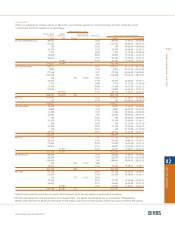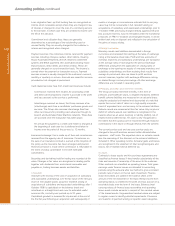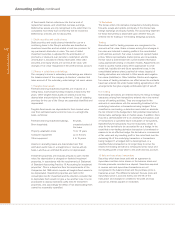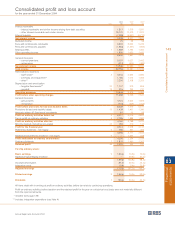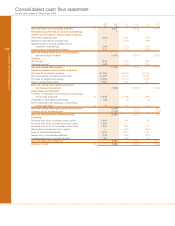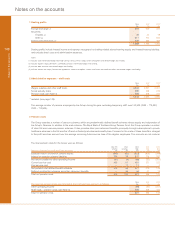RBS 2004 Annual Report Download - page 142
Download and view the complete annual report
Please find page 142 of the 2004 RBS annual report below. You can navigate through the pages in the report by either clicking on the pages listed below, or by using the keyword search tool below to find specific information within the annual report.
140
Accounting policies
Loan origination fees: up-front lending fees are recognised as
income when receivable except where they are charged in lieu
of interest or charged to cover the cost of a continuing service
to the borrower, in which case they are credited to income over
the life of the advance.
Commitment and utilisation fees: these are generally
determined as a percentage of the outstanding used or
unused facility. They are usually charged to the customer in
arrears and recognised when charged.
Payment services: this comprises income received for payment
services including cheques cashed, direct debits, Clearing
House Automated Payments (the UK electronic settlement
system) and BACS payments (the automated clearing house
that processes direct debits and direct credits). These are
generally charged on a per transaction basis. The income is
earned when the payment or transaction occurs. Payment
services income is usually charged to the customer’s account,
monthly or quarterly in arrears. Accruals are raised for services
provided but not charged at period end.
Card related services: fees from credit card business include:
Commission received from retailers for processing credit
and debit card transactions: income is accrued to the profit
and loss account as the service is performed.
Interchange received: as issuer, the Group receives a fee
(interchange) each time a cardholder purchases goods and
services. The Group also receives interchange fees from
other card issuers for providing cash advances through its
branch and Automated Teller Machine networks. These fees
are accrued once the transaction has taken place.
An annual fee payable by a credit card holder is charged at
the beginning of each year but is deferred and taken to
income over the period of the service i.e. 12 months.
Insurance brokerage: this is made up of fees and commissions
received from the agency sale of insurance. Commission on
the sale of an insurance contract is earned at the inception of
the policy as the insurance has been arranged and placed.
However, provision is made where commission is refundable in
the event of policy cancellation in line with estimated
cancellations.
Securities and derivatives held for trading are recorded at fair
value. Changes in fair value are recognised in dealing profits
together with dividends from, and interest receivable and
payable on, trading business assets and liabilities.
3 Goodwill
Goodwill is the excess of the cost of acquisition of subsidiary
and associated undertakings over the fair value of the Group’s
share of net tangible assets acquired. Goodwill arising on
acquisitions of subsidiary and associated undertakings after 1
October 1998 is capitalised on the balance sheet and
amortised on a straight-line basis over its estimated useful
economic life, currently over periods up to 20 years.
Capitalised goodwill is reviewed for impairment at the end of
the first full year following an acquisition and subsequently if
events or changes in circumstances indicate that its carrying
value may not be recoverable in full. Goodwill arising on
acquisitions of subsidiary and associated undertakings prior to
1 October 1998, previously charged directly against profit and
loss account reserves, was not reinstated under the transitional
provisions of FRS 10 ‘Goodwill and Intangible Assets’. It will be
written back only on disposal and reflected in the calculation of
the gains or losses arising.
4 Foreign currencies
Monetary assets and liabilities denominated in foreign
currencies are translated into sterling at the rates of exchange
ruling at the balance sheet date. Profit and loss accounts of
overseas branches and subsidiary undertakings are translated
at the average rates of exchange for the period. Exchange
differences arising from the application of closing rates of
exchange to the opening net assets of overseas branches and
subsidiary undertakings and from restating their results from
average to period-end rates are taken to profit and loss
account reserves, together with exchange differences arising
on related foreign currency borrowings. All other exchange
differences are included in operating profit.
5 Pensions and other post-retirement benefits
The Group provides retirement benefits, in the form of
pensions and healthcare plans, to eligible employees. Defined
benefit scheme liabilities are measured on an actuarial basis
using the projected unit method and discounted at a rate that
equals the current rate of return on a high quality corporate
bond of equivalent term and currency to the scheme liabilities.
Scheme assets are measured at their fair value. Any surplus or
deficit of scheme assets over liabilities is recognised in the
balance sheet as an asset (surplus) or liability (deficit), net of
related notional deferred tax. An asset is only recognised to
the extent that the surplus can be recovered through reduced
contributions in the future or through refunds from the scheme.
The current service cost and any past service costs are
charged to the profit and loss account within Administrative
expenses – staff costs. The expected return on scheme assets
less the unwinding of the discount on the scheme liabilities is
included in Other operating income. Actuarial gains and losses
are recognised in the statement of total recognised gains and
losses, net of related notional deferred tax.
6 Leases
Contracts to lease assets and hire purchase agreements are
classified as finance leases if they transfer substantially all the
risks and rewards of ownership of the asset to the customer.
Other contracts are classified as operating leases. Total gross
earnings under finance leases are allocated to accounting
periods using the actuarial after tax method to give a constant
periodic rate of return on the net cash investment. Finance
lease receivables are stated in the balance sheet at the
amount of the net investment in the lease. Rental income from
operating leases is credited to the profit and loss account on a
receivable basis over the term of the lease. Balance sheet
carrying values of finance lease receivables and operating
lease assets include amounts in respect of the residual values
of the leased assets. Unguaranteed residual values are subject
to regular review to identify potential impairments. Provisions
are made for impairment arising on specific asset categories.
Accounting policies continued



